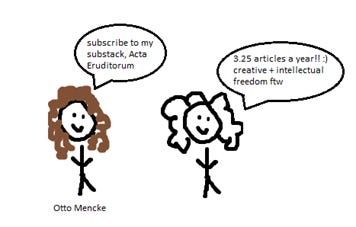I write data-driven, statistical thought pieces on the nuances of human behavior about once a week! Check out my whole portfolio of work here.
In a letter to Helen Keller, Mark Twain wrote:
"It takes a thousand men to invent a telegraph, or a steam engine, or a phonograph, or a photograph, or a telephone or any other important thing — and the last man gets the credit and we forget the others. He added his little mite — that is all he did. These object lessons should teach us that ninety-nine parts of all things that proceed from the intellect are plagiarisms, pure and simple; and the lesson ought to make us modest. But nothing can do that." - Mark Twain
“All things that proceed from the intellect are plagiarisms.” Most ideas that have been had, have already been had before.
It feels odd to think that there might be no such thing as “true innovation”. We think of inventors as tucked away in a dark room somewhere, thinking and plotting and prodding, alone in their pursuit of creation.
But so much of the grandiose of invention and discovery is really based in collaboration and competition, the iterations of past science, conversations, and support from outside resources.
Scientific discoveries depend on network effects. Human connections are the underlying current in most of the innovation that we have today. Discovery is the chaotic storm of many things. After all, “invention has its own algorithm: genius, obsession, serendipity, and epiphany in some unknowable combination”, as Malcom Gladwell says.
It is not the lone genius, siloed away in a study.
It’s humans talking to other humans. But this human element also means discovery is wrought with human error.
In the case of Gottfried Leibniz and Isaac Newton, this human interference, simultaneous discovery, and network effects led to one of the most brutal battles of all time: The Calculus Wars.
Gottfried Leibniz and Isaac Newton
Gottfried Leibniz discovered calculus around the same time as Isaac Newton - but both came to the discovery separate from one another. This was because of shared networks: the two men inhabited the same social circles and were having the similar conversation with all the same people.
It’s entirely logical that they would have similar thought patterns.
But this social element of discovery wasn’t recognized by Newton. Newton stamped out Leibniz.
Gottfried Leibniz was many things: a polymath, an inventor, a contributor to binary notation, and a major figure in Philosophy. He also had a series of important friendships and occurrences (some estimating that he had 600+ correspondents), appearing to be almost serendipitous in nature.
This is his story.
The Story of Gottfried Leibniz
Leibniz was born in Leipzig, which was then a part of the Holy Roman Empire. When Leibniz was a kid, he had full access to his father's library. This unlimited channel of knowledge was a catalyst to Leibniz's future.
At 14, he went to the University of Lepzig. He defended Disputatio Metaphysica de Principio Individui; based off the principle of individuation. He then went on to write a book, De Arte Combinatoria, in which he argued that a God existed through geometric and cosmological proofs. He also got his license to practice law in the same year.
After all of this, he ended up leaving academia to land his first job in alchemical studies (which he somewhat ironically knew very little about).
The Power of a Hype Man
Leibniz was hired by Johann Christian von Boyneburg. Johann was his first friend and one of the most important. He was politically connected, and introduced Leibniz to Johann Philipp von Schönborn, the Elector of Mainz.
This was a big deal.
Johann Philipp von Schönborn was not only the Elector of Mainz, but also the archchancellor of the Holy Roman Empire.
Leibniz had met one of the most powerful people in the world.
All the while, von Boyneburg was promoting Leibniz and his work, creating inroads and networks that would accelerate Leibniz’s career. In an effort to get noticed by the von Schönborn for a job, Leibniz wrote an essay on law. von Schönborn liked it and subsequently hired him to the court (with the small task of rewriting the laws of the Electorate).
Leibniz made his way up the political ladder. But those plans mostly fell through, as the Franco-Dutch war broke out. So, a dejected Leibniz went to Paris in 1672, seeking purpose.
Make Friends, Influence Yourself
While in Paris, he met Christiaan Huygens, a brilliant physicist and mathematician. After spending time with Huygens, Leibniz became aware of his own shortcomings and began a course of self-study to improve his overall skillset. He discovered calculus in this process (around 1675), developing a complete theory over the course of 2 months.
While in Paris, Leibniz also met Antoine Arnauld and Nicolas Malebranche, the most prominent French philosophers of the day. Through them, he spent more time on the work on Pascal and Descartes, further influencing his knowledge.
He also met Ehrenfried Walther von Tschirnhaus and the two would remain friends for the rest of their lives as mathematical pen pals. Leibniz set out some of his calculus work in their correspondence, and the two built and learned from one other.
The Calculus Drama Begins
Leibniz published his work on differential calculus in 1684. Two years later, in 1686, his second work on calculus was published. He published his full calculus theory in 1693.
At this same time, Newton had published Principia in 1687, which mentioned his thoughts on calculus. Newton notes that he had thought of calculus first, in 1666, while on his break from school during the Black Plague. He didn't put out any formal work on the subject until 1693.
Things were fine. The two acknowledged one another. They spoke to the same people.
All of that would soon change.
The Power of Community (and intellectual freedom)
Leibniz then traveled to London on official business for von Schönborn and also had a chance to show off the calculator he built. There, he met Henry Oldenburg, an original fellow at the Royal Society, and John Collins. John Collins was talking to all the top minds of the time, ranging from Borelli, Isaac Newton, Wallis, Isaac Barrow etc.
John Collins was a community builder.
One can only imagine the insights that Leibniz gleaned from his time with both (and the insights that that they gleaned from him in return).
However, when von Schönborn died, Leibniz was suddenly left without a job.
Duke John Frederick of Brunswick (the eventual Elector of the Holy Roman Empire) had repeatedly invited Leibniz to Hanover (which Leibniz had ignored). But after getting rejected from countless positions, Leibniz had no choice. He made the trek to Hanover in 1676. And he was there over 40 years.
While in Hanover, Leibniz befriended Sophia of Hanover and her daughter, Sophia Charlotte. Sophia's line inherited the Royal England throne under the British Act Settlement 1701. Serendipitously, Leibniz now knew some of the most powerful people in Europe. And the both of the Sophias really liked him.
They let him do whatever he wanted while he was at Hanover. During this time, he published 13 works over the course of 4 years.
He published everything in the first scientific journal of Germany, Acta Eruditorium, started by Otto Mencke.
The Downfall
Unfortunately, things went downhill for Leibniz after that.
Commercium Epistolicum was published in 1712, thoroughly accusing Leibniz of plagiarism. Leibniz was never given the opportunity to defend himself. The Royal Society (of which Newton was president) ended up discrediting Leibniz's calculus in favor for Newton's. Leibniz and his reputation were crushed.
Leibniz died 2 years later. Only his secretary attended his funeral. No one honored his death. No one respected the life of a man who had given so much to society.
All because of Isaac Newton.
The Power of Networks
The Calculus controversy dampened the last few years of Leibniz's life. But the thing was, many had already thought of the principles that Newton and Leibniz laid out, including Simon Stevin, Luca Valerio, and Johannes Kepler.
And everyone invented it independently of one another. But also, everyone was entirely dependent on each other.
Newton and Leibniz worked together on power series. They corresponded in several letters about the mathematics that they were working on.
They were all hanging out with all the same people. Logically, they were going to have similar thought patterns and processes. The scientific community was tightly knit, practically an incubator for innovation.
Both Leibniz and Newton had many conversations that heavily influenced them. It makes sense that they both invented calculus at the same time. Just based on the momentum of the era, if they hadn't someone else would have.
Robert Merton, more eloquently called this the "multiple effect":
"The discoveries are simultaneous or almost so; sometimes a scientist will make a new discovery which, unknown to him, somebody else has made years before."
So despite a tragic ending that Gottfried Leibniz did not deserve – we know one thing. Leibniz had many friends that helped him get to where he got, just as Isaac Newton relied on his friends to destroy Leibniz.
Friendships & connections are the key driving force behind most of the scientific discoveries we have. They get us further than we can go alone.
And this power must be used wisely.





















I love this so much thank you for making this
sad about leibniz... really hope we can influence our social graphs to be kinder, more collaborative and encouraging